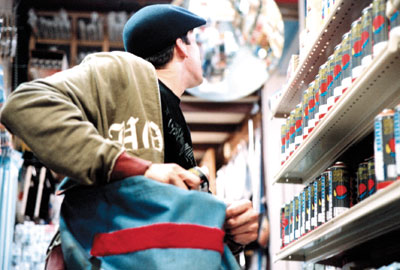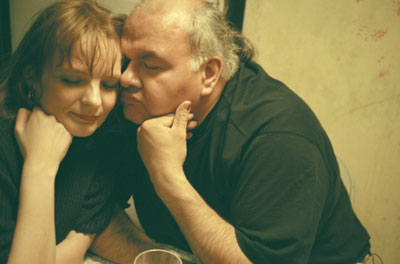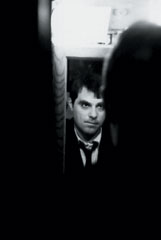IN FOCUS: SIX IN POST
Mary Glucksman profiles new independently-financed features.
QUALITY OF LIFE
 |
| Quality of Life. |
Bay Area filmmaker Benjamin Morgan want his first feature, Quality of Life, to illuminate graffiti writers the way Slam revealed the power of the spoken word. “Graffiti artists are challenged because their art form is criminalized — they’re basically defacing property,” he says. “A lot of the kids doing it are at-risk kids from the street who don’t have alternative creative outlets. We spend $15 to $18 billion a year in the U.S. to eradicate graffiti but 80 percent of inner city schools don’t have arts programs. If we put some of that money on the front end and gave these kids an outlet, maybe they wouldn’t be so destructive.” Life stars Brian Burnam and newcomer Lane Garrison as 20-year-old Mission District graffiti writers who choose different paths when they get busted.
Morgan, 33, wrote the script with lifelong San Francisco graffiti artist Burnam after spurning film school to train himself El Mariachi–style by making three no-budget featurettes. “Robert Rodriguez was really the impetus,” Morgan says. “I read his book and it lit my fire at a time I was considering applying to film school. I’d been around movies and played bit parts as a kid because my dad was in sound and my mom was in casting. When I didn’t get into UCLA the first time around, I got a degree in psychology and spent 10 years working with at-risk kids.”
The Super 16mm cinéma vérité Life shot for 18 days beginning July 28 with Kev Robertson (She Kept Silent) as d.p. “Graffiti is all about creating strong, compelling images with little or no resources,” Morgan continues. “We adopted that as our model to get this [film] made with planning, teamwork and passion in place of a bigger budget.”
Contact: Benjamin Morgan at ben@qualityoflife-themovie.com
EVERGREEN
 |
| Evergreen. |
“There are many layers to the film, but it’s a simple story,” says Enid Zentelis about Evergreen, her first feature, about a teenage girl and her single mom making a fresh start in a small town near Seattle. In its “sense of a small town as a community,” Zentelis places her film in a tradition that includes The Last Picture Show and What’s Eating Gilbert Grape.
A 1999 graduate of NYU’s MFA film program, Zentelis, 32, won a Grand Marnier Award for her short Dog Race and workshopped Evergreen at the 2000 Sundance filmmakers lab. She got through production outside Seattle this spring with support from Sundance, at which point Eva Kolodner and Yael Melamede’s new Salty Features came on board to shepherd the film from post through completion. “The footage sold us,” says Kolodner, an exec at Killer and Madstone before founding Salty. “It’s a beautiful story about growing up with a vista that’s unique, and the performance she got out of the 14-year-old lead gave us a lot of confidence.” Seattle discovery Addie Land makes her debut as Henry with Cara Seymour (Adaptation) as her mother; Bruce Davison, Noah Fleiss and Mary Kay Place co-star.
The 35mm and HD Evergreen shot for three weeks with d.p. Matt Clark (Cosmopolitan) and a local crew. Wilco’s John Stirratt is collaborating on the soundtrack and sonic design.
Contact: Yael Melamede at info@saltyfeatures.com
ADDICTION
 |  |
| Addiction. | |
James Tucker wants to be the next Abel Ferrara, and his new film, Addiction, could bag him the tag, even though Ferrara used the same title for his 1995 vampire flick. “[Ferrara’s] Driller Killer was a huge influence,” Tucker explains. “I decided to do B movies and move on from there, like he did.”
Tucker’s Addiction, his second collaboration with actor and writer Joshua Nelson, is about a clean-cut New York businessman who kills a mugger in self-defense and gets such a rush that he’s compelled to kill again. “This is the first time in his life he’s felt powerful,” the director says. “It’s a horror story about the human heart.”
A journeyman actor with a number of direct-to-video thrillers to his credit, Tucker, 40, found Nelson by plastering Web sites with “writer wanted” notices. A 1987 graduate of Manhattan’s prestigious High School of Performing Arts, Nelson had appeared in soaps, horror flicks and Manhattan cabaret but was still living paycheck to paycheck. “Work was so slow,” he recalls, “so I sent James my play Savage Roses, about a Latina gangbanger giving it up for the woman of her dreams. He picked it out of 100 submissions, and we made it in six days. Even though it’s got a lot of technical ineptitude, it went to four major [gay and lesbian] festivals, and it looks like it’s getting a distributor.”
The almost-no-budget Addiction, which the duo shot next, was lensed in New York in April with Tucker handling Panasonic’s new 24p AG-DVX100 and Nelson supporting a cast of seasoned off-Broadway players. Says Nelson, “Our method is, I cast and rehearse, and James comes in to set up and shoot.”
Contact: Joshua Nelson at addictionemail@aol.com
FROM OTHER WORLDS
Screenwriter-turned-director Barry Strugatz says his debut sci-fi feature From Other Worlds has been described as “Indiana Jones meets Close Encounters in Brooklyn.” The film stars The Hulk’s Cara Buono as a depressed housewife who gets a second lease on life after a UFO lands in her backyard and she meets a struggling African immigrant (Ghost Dog’s Isaach De Bankolé) at a support group. “On the one hand it’s an entertaining comedy that pokes fun at people who encounter UFOs, but on another level it’s about two people trying to bridge the gulf of cultural and class differences. My touchstones were A Woman Under the Influence, the ’40s Cat People and Rosemary’s Baby.”
A graduate of NYU’s film school, Strugatz spent years working in production in New York and is best known as the screenwriter of Married to the Mob and She-Devil. “I wrote a lot of other films I got paid for that never got made, and it was frustrating. Meanwhile I’d been able to watch really good directors at work, so I decided it was time to make my own,” he says. He made his directorial debut with the 30-minute sci-fi short The Transformation and then hooked up with producer Diana Williams (Our Song), who brought in Belladonna Productions’ René Bastian and Linda Moran (L.I.E.).
The private-equity-financed Worlds shot in New York for five weeks beginning in June with top Hollywood gaffer Morris “Mo” Flam (Cold Mountain) in his first turn as d.p. “Because of Mo we had a Steadicam available at all times and we shot running chases down Fifth Avenue on a weekday,” Strugatz says. New York special-effects house Quantum Films is supplying visual components.
Contact: Diana Williams at diana@exit5entertainment.com
MARIE AND BRUCE
Julianne Moore and Matthew Broderick channel the vicissitudes of a free-falling New York marriage in Marie and Bruce. The film was adapted from Wallace Shawn’s 1980 play by Shawn and director Tom Cairns, who describes it as “a latter-day Virginia Woolf, but very much in its own world.” Cairns met Shawn in 1999 when he directed his play Aunt Dan and Lemon for the London Stage. “Wally’s famous for giving characters speeches that last three pages, but this play has a whole other side — internalized or descriptive passages and surreal dreams — that lent itself to film. Marie says, ‘I met a dog with a wonderful face, and we went to a garden,’ and in the film we actually go to the garden.”
An earlier version of Marie was in development for a decade; this one got made fast after George Van Buskirk and David Newman stepped in with their five-year-old Holedigger Films (Roger Dodger) this spring. “Tom took Wally’s play and brought in visual characteristics like cracking open an Easter egg,” says Van Buskirk. “Every word of Wally’s, every inflection has a purpose. The back-and-forth that goes on is very Hepburn-and-Tracy in a way. Tom represents its dreamy nature with effects like having the garden grow as Julianne moves through it.”
Marie was shot on film in New York over 22 days this May and is being posted digitally with Twinkle, the outfit that supplied American Splendor’s graphics, before a transfer back to film. “They bring a lot to the table creatively,” Van Buskirk says. “We can lay in opticals that would normally cost a fortune, do all sorts of things we wouldn’t have the flexibility to do posting on film.” Those include a shrinking woman flying through an apartment during a dream sequence. Also in the cast are Bob Balaban, Griffin Dunne and Julie Hagerty.
Contact: George Van Buskirk at george.vanbuskirk@verizon.net
THE MOTEL
“There’s a 13-year-old Chinese kid sitting on a dumpster talking dirty to his egg roll. This is Ernest Chin,” says Michael Kang about the protagonist of his first feature The Motel, a coming-of-age story pairing the fatherless Ernest with a questionable man, Sam, who checks into his mom’s sleazy motel and takes him under his wing. “It’s a mix of humor and heavy stuff — heartbreaking but hopeful.”
Kang grew up “in academia in Rhode Island,” where his Korean immigrant parents were college professors and later graduated from NYU’s dramatic writing program. Best known for his performance in Greg Pak’s Asian Pride Porn, his own short, Japanese Cowboy, was a 2000 prizewinner. “I had a draft [of The Motel], and I envisioned a 16mm shoot with She’s Gotta Have It as my model,” he says. That changed with a trip to the Sundance lab, where adviser Miguel Arteta offered to produce Motel with longtime partners Matthew Greenfield and Gina Kwon and brought along his Star Maps financiers Richard and Esther Shapiro. “It’s been a 180-degree turn for me,” Kang says. “I went into the labs with an idea and came out with a good story. One of the most elemental aspects [of this film] is that you should feel compassion for all the characters — this is the human condition — and I think that’s how Miguel approaches his stories.”
Motel’s five-week 35mm shoot rolled August 4 in upstate New York with d.p. Lisa Leone (Dirt). Kang’s search for the right cast had him “trolling the streets” until he found Jeffrey Chyaun for Ernest. “There aren’t that many Asian-American child actors,” Kang says. “It’s not something their parents encourage.” Sung Kang (Better Luck Tomorrow) plays Sam.
Contact: motelfilm@aol.com
VOD CALENDAR


 See the VOD Calendar →
See the VOD Calendar →


